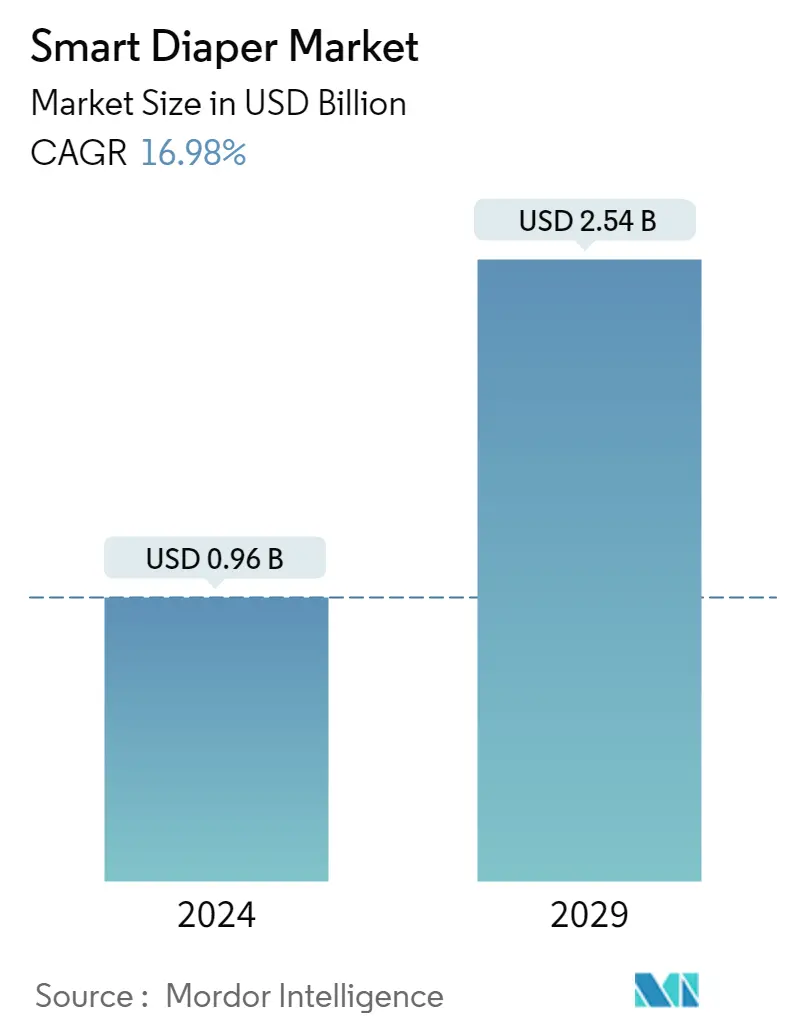Market Size of Smart Diaper Industry

| Study Period | 2019 - 2029 |
| Market Size (2024) | USD 0.96 Billion |
| Market Size (2029) | USD 2.54 Billion |
| CAGR (2024 - 2029) | 16.98 % |
| Fastest Growing Market | Asia-Pacific |
| Largest Market | North America |
| Market Concentration | Medium |
Major Players
*Disclaimer: Major Players sorted in no particular order |
Smart Diaper Market Analysis
The Smart Diaper Market size is estimated at USD 0.96 billion in 2024, and is expected to reach USD 2.54 billion by 2029, growing at a CAGR of 16.98% during the forecast period (2024-2029).
The global market is propelled by the growing utilization of technology to aid nuclear and working families in regard to childcare.
- A smart diaper is a form of undergarment that provides individuals with alerts regarding the need for a diaper change or if it becomes wet. The system of a smart diaper consists of sensors that are connected to mobile applications. Once a sensor detects a leak promptly identifies and activates an alarm. The market for smart diapers is expanding due to the rise in disposable incomes, the aging population in affluent countries, and the growing population in emerging nations. Furthermore, this innovation is considered one of the most remarkable advancements in continence care. It is expected that the increased utilization of smart diapers in hospitals, clinics, and nursing homes will contribute to the growth of the smart diaper market.
- A smart diaper is an advantageous undergarment equipped with an RFID sensor that notifies parents when it is necessary to change the baby. However, in the case of a soiled diaper, equivalent to two wet diapers, immediate action is required to prevent skin irritation and discomfort for the baby. Smart diapers serve as a means to assist parents in averting potential skin irritations and associated issues caused by prolonged diaper usage, ensuring the baby's well-being.
- The expanding senior population will likely influence the anticipated market growth in the forthcoming years. As families search for inventive approaches to baby care and with the rise in the elderly population, the demand for smart diapers equipped with advanced features and functionalities is projected to escalate, thereby propelling the overall market growth in the global smart diapers market.
- The primary product categories within the smart diaper industry encompass both infant and adult diapers. Adult diapers are specifically designed to assist elderly individuals who experience daily challenges such as dementia, urinary or fecal incontinence, diarrhea, or limited mobility. In addition to facilitating effective care, smart diapers have the potential to aid in the early detection of health conditions, including constipation, skin irritations, allergies, and incontinence.
- The market's growth is hindered by two main obstacles: insufficient consumer product knowledge and the exorbitant cost of smart-connected diapers in comparison to conventional ones. Moreover, smart diapers designed for adults present specific drawbacks such as prolonged dehydration, recurrent urinary tract infections, and the potential development of renal issues.
- The COVID-19 pandemic outbreak affected the market positively. The effect of the outbreak led to the breakup of the childcare business, which was outsourced to many agencies and professional childcare providers. Though various platforms tried to provide properly screened caregivers, the threat of the pandemic forced parents to get involved in baby care directly. This was expected to impact the market positively.
Smart Diaper Industry Segmentation
Smart diapers are diapers integrated with sensors that enable effective care for babies and the elderly. Smart diapers are equipped with sensors that are connected to mobile applications that send out alerts as soon as they detect any leak.
The smart diaper market has been segmented by end users (baby and adult) and geography (North America, Europe, Asia-Pacific and Rest of the World). The market sizes and forecasts are provided in terms of value (USD) for all the above segments.
| End-User Industry | |
| Baby | |
| Adult |
| Geography | |
| North America | |
| Europe | |
| Asia-Pacific | |
| Rest of the World |
Smart Diaper Market Size Summary
The smart diaper market is poised for significant growth, driven by the increasing integration of technology in childcare solutions for both nuclear and working families. Smart diapers, equipped with sensors and mobile app connectivity, alert caregivers when a change is needed, enhancing convenience and reducing the risk of skin irritations for infants. The market's expansion is supported by rising disposable incomes, an aging population in developed countries, and a growing population in emerging markets. This innovative product is gaining traction in healthcare settings such as hospitals and nursing homes, where it aids in continence care and early detection of health issues. Despite challenges like high costs and limited consumer awareness, the market is expected to benefit from the growing demand for smart connected products and IoT devices.
The Asia-Pacific region is anticipated to experience the fastest growth in the smart diaper market, fueled by a large and increasing population, urbanization, and the prevalence of nuclear families. Countries like India, China, and South Korea are emerging as key markets, with advancements in healthcare and technology driving demand. The region's aging population further contributes to market potential, as smart diapers offer solutions for elderly care in nursing homes and healthcare facilities. The market is semi-consolidated, with ongoing product innovations and launches, such as those by Pixie Scientific and Penn State University, highlighting the sector's dynamic nature. The rise of e-commerce and the convenience of online shopping also play a crucial role in market expansion, providing manufacturers with opportunities to enhance their digital presence and reach a broader consumer base.
Smart Diaper Market Size - Table of Contents
-
1. MARKET INSIGHTS
-
1.1 Market Overview
-
1.2 Industry Attractiveness - Porter's Five Forces Analysis
-
1.2.1 Bargaining Power of Buyers/Consumers
-
1.2.2 Bargaining Power of Suppliers
-
1.2.3 Threat of New Entrants
-
1.2.4 Threat of Substitute Products
-
1.2.5 Intensity of Competitive Rivalry
-
-
1.3 Assessment of Impact of COVID-19 on the Industry
-
-
2. MARKET SEGMENTATION
-
2.1 End-User Industry
-
2.1.1 Baby
-
2.1.2 Adult
-
-
2.2 Geography
-
2.2.1 North America
-
2.2.2 Europe
-
2.2.3 Asia-Pacific
-
2.2.4 Rest of the World
-
-
Smart Diaper Market Size FAQs
How big is the Smart Diaper Market?
The Smart Diaper Market size is expected to reach USD 0.96 billion in 2024 and grow at a CAGR of 16.98% to reach USD 2.54 billion by 2029.
What is the current Smart Diaper Market size?
In 2024, the Smart Diaper Market size is expected to reach USD 0.96 billion.

